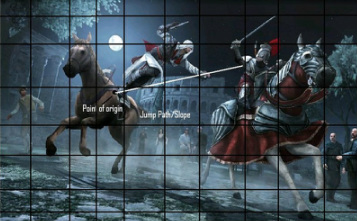Unit 4: Linear Functions
 A job that would require Point-Slope Form would be a Computer Game Animator. A Computer Game Animator uses a Coordinate Grid. When he wants to make character to do an action, such as jump, he moves the character a few spaces up and a few spaces forward.
A job that would require Point-Slope Form would be a Computer Game Animator. A Computer Game Animator uses a Coordinate Grid. When he wants to make character to do an action, such as jump, he moves the character a few spaces up and a few spaces forward.
Inexperienced Animators earn an average of $46,700, Animators with more then three years of experience make an average of $67,000 a year. Once you have six years of experience as a video game animator you can now earn just over $75K a year.
To learn more visit http://pt-slopeform.weebly.com/real-world-situations.html
Section 4.1: What makes a function linear?
Students distinguish non-linear functions from linear functions by exploring distance as a function of time in verbal, graphical and tabular form. Students learn that linear functions are characterized by a constant rate of change.
Section 4.2: Recognizing Linear Functions from Words, Tables and Graphs
Students recognize linear functions in tabular and graphical forms and represent functions with verbal descriptions, equations, graphs, and tables. Students will develop methods for identifying the characteristics of linear functions and an understanding of rate of change and initial value in a real word context.
Section 4.3: Calculating and Interpreting Slope
Students discover how to identify the slope of a linear function from a table, two ordered pairs, graph and the verbal description of a linear function. Students also learn how to interpret the slope in the context of real world situations.
Section 4.4: Effects of Changing Parameters of an Equation in Slope Intercept Form
Students examine how changes in the parameters m and b in slope-intercept form affect the function’s graph.
Section 4.5: Forms of Linear Equations
Students learn about direct variation as an equation in slope-intercept form that has a y-intercept of zero. Students are introduced to the standard form of linear equations, rewrite equations in standard form into slope-intercept form, and use linear models in various forms to explore real world situations.
Section 4.6: Point Slope Form of Linear Equations
Students learn to use the point-slope form of a linear equation and develop a deeper understanding of functions as they solve a variety of contextual problems. Students discover that the slope-intercept, point-slope and standard forms of a linear equation are equivalent, and students learn to select a form that best fits the data or the question to be answered.
 A job that would require Point-Slope Form would be a Computer Game Animator. A Computer Game Animator uses a Coordinate Grid. When he wants to make character to do an action, such as jump, he moves the character a few spaces up and a few spaces forward.
A job that would require Point-Slope Form would be a Computer Game Animator. A Computer Game Animator uses a Coordinate Grid. When he wants to make character to do an action, such as jump, he moves the character a few spaces up and a few spaces forward.